Related Research Articles

Malvasia, also known as Malvazia, is a group of wine grape varieties grown historically in the Mediterranean region, Balearic Islands, Canary Islands and the island of Madeira, but now grown in many of the winemaking regions of the world. In the past, the names Malvasia, Malvazia, and Malmsey have been used interchangeably for Malvasia-based wines; however, in modern oenology, "Malmsey" is now used almost exclusively for a sweet variety of Madeira wine made from the Malvasia grape. Grape varieties in this family include Malvasia bianca, Malvasia di Schierano, Malvasia negra, Malvasia nera, Malvasia nera di Brindisi, Malvasia di Candia aromatica, Malvasia odorosissima, and a number of other varieties.

Sangiovese is a red Italian wine grape variety that derives its name from the Latin sanguis Jovis, "the blood of Jupiter".

Lambrusco is the name of both an Italian red wine grape and a wine made principally from said grape. The grapes and the wine originate from four zones in Emilia-Romagna and one in Lombardy―principally around the central provinces of Modena, Parma, Reggio-Emilia, and Mantua. The grape has a long winemaking history, with archaeological evidence indicating that the Etruscans cultivated the vine. In Roman times Lambrusco was highly valued for its productivity and high yields, with Cato the Elder stating that produce of two-thirds of an acre could make enough wine to fill 300 amphoras.
Refosco is a very old family of dark-skinned grape varieties native to the Venetian zone and neighbouring areas of Friuli Venezia Giulia, Gavi, Trentino, Istria, and Karst Plateau. It is considered autochthonous in these regions.
Ancellotta is a wine grape variety mainly grown in the Emilia-Romagna region of Italy, but also in some other parts of north Italy, and in south Switzerland.

Aleatico is a red Italian wine grape variety. It is notable for being the primary grape in the cult wine Aleatico di Portoferraio made in Elba. In Chile is known as Red Moscatel. The grape has also been cultivated at Mudgee in New South Wales and California.
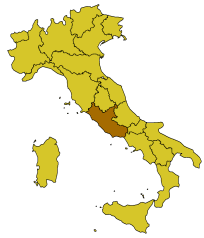
Cesanese Comune is a red Italian wine grape variety that is grown primarily in the Lazio region. The grape has three Denominazione di origine controllata (DOC) regions dedicated to it-Cesanese di Affile DOC, Cesanese di Olevano DOC and Cesanese di Piglio DOC. Cesanese di Affile appears to be a distinct sub-variety of Cesanese Comune unique to the commune of Affile. There are noticeable differences between Cesanese Comune and the grapes found in Cesanese di Affile, including the size of the grape berry itself. The sub-variety Cesanese d'Affile is considered to be of superior quality of Cesanese Comune and is used as minor ingredient in the Tuscan cult wine Trinoro. The grape has very old origins, and may have been used in Roman winemaking. Today it is rarely seen outside of the Lazio.
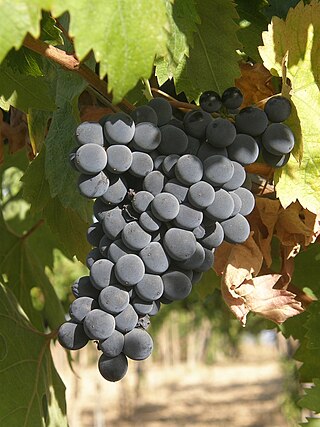
Montepulciano is a red Italian wine grape variety that is most noted for being the primary grape behind the DOCG wines Colline Teramane Montepulciano d'Abruzzo and Offida Rosso; and the DOC wines Montepulciano d'Abruzzo, Rosso Conero, and Rosso Piceno Superiore.
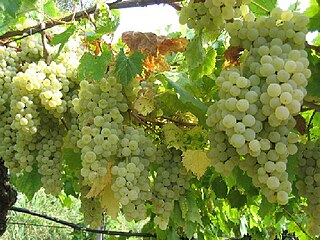
Durella or Durello is a white Italian wine grape variety originating from the Veneto wine region of northeast Italy. Today it is sparsely cultivated, though some producers like to experiment with it since its high acid levels makes it suitable for sparkling wines.

Lombardy wine is the Italian wine produced in the Lombardy region of north central Italy. The region is known particularly for its sparkling wines made in the Franciacorta and Oltrepò Pavese areas. Lombardy also produces still red, white and rosé wines made from a variety of local and international grapes, including Nebbiolo wines in the Valtellina region and Trebbiano di Lugana white wines produced with the Chiaretto style rosé along the shores of Lake Garda. The wine region currently has 22 denominazione di origine controllata (DOC), 5 denominazione di origine controllata e garantita (DOCG) and at least 13 indicazione geografica tipica (IGT) designations. The main cities of the region are Milan, Bergamo and Brescia. The region annually produces around 1.3 million hectolitres of wine, more than the regions of Friuli-Venezia Giulia, Marche, Trentino-Alto Adige/Südtirol and Umbria.
Terrano is a Slovenian and Italian wine variety, bearing the mark of recognized traditional denomination. It is a member of the Refosco family of grape varieties, which also includes Refosco dal Peduncolo Rosso. Since 2006 it is a wine with a protected designation of origin (PDO) within European Union under the protected designation "Teran".
Refosco dal Peduncolo Rosso is a red Italian wine grape grown predominantly in the Friuli Venezia Giulia region of northeast Italy. The grape is a variety in the Refosco family and derives its name from its red stems. It is found in the Denominazione di origine controllata (DOC) of Colli Orientali del Friuli, Friuli Aquileia, Friuli Grave and Friuli Latisana. It is also found in the Veneto portion of the Lison Pramaggiore and in the Slovenian wine region of Koper. In Slovenia, Refosco dal Peduncolo Rosso and Refosco are both called Terrano and are commonly used in a field blend.

Grechetto or Grechetto bianco is a white Italian wine grape variety of Greek origins. The grape is planted throughout central Italy, particularly in the Umbria region where it is used in the Denominazione di origine controllata (DOC) wine Orvieto and Denominazione di origine controllata (DOC) wine Valdichiana Toscana. It is primarily a blending grape, though some varietal wine is also produced. Grechetto is commonly blended with Chardonnay, Malvasia, Trebbiano and Verdello. The grape's thick skin provides good resistance to downy mildew which can attack the grape late in the harvest season. This makes Grechetto a suitable blending grape in the production of Vin Santo.
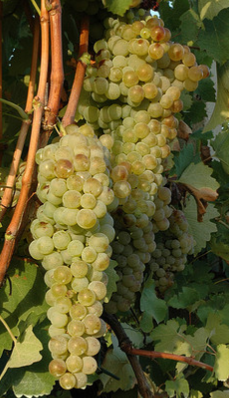
Albana is a white Italian wine grape planted primarily in the Emilia-Romagna region.

Bombino bianco is a white Italian wine grape variety planted primarily along Italy's Adriatic coast line, most notably in Apulia. The vine is prone to high yields and often produces neutral flavor wines. The grape is known under many synonyms throughout Italy including Debit and Pagadebit, names which came from the grape's reputation for being a high yielding and reliable crop for vineyard owners to grow that would assure them that on each vintage they could pay off their debts.
Biancame is a white Italian wine grape variety that is grown in the Marche and Emilia-Romagna regions of Italy. Here it is an important component in the Denominazione di origine controllata (DOC) wines of Bianchello del Metauro and Colli di Rimini.
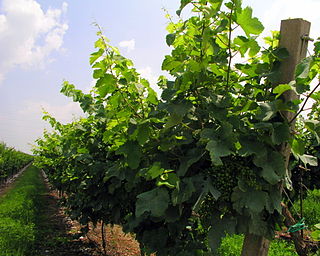
Glera is a white variety of grape of Italian origin, possibly from the namesake village, Prosecco. The variety was formerly mostly referred to as Prosecco, but in the EU was renamed "Glera" in 2009 to make room for the protection of "Prosecco" as the name of the Italian geographically-protected wine.

Incrocio Manzoni or Manzoni grapes is a family of grape varieties named after Professor Luigi Manzoni (1888-1968) of Italy's oldest school of oenology located in Conegliano, in the Veneto region. Manzoni created the new grape varieties by selecting, crossing and grafting vines from various vineyards during the 1920s and 1930s. The family includes both white and red grape varieties. Although most Manzonis are grown in northeastern Italy, they are mainly grown in the Piave area of Province of Treviso and are only now starting to be sold commercially in Europe and the United States.
Carso – Kras is an Italian wine-producing zone located in the provinces Trieste and Gorizia in the Friuli-Venezia Giulia region, on the border with Slovenia. It was classified as a Denominazione di Origine Controllata (DOC) in 1985 and produces both red and white wine. It takes its name from the Karst Plateau and covers 57 hectares. It has produced 1, 080 hl total 2013/2014, with an average of 11, 240 cases bottled annually.

Abruzzo is an Italian wine region located in the mountainous central Italian region of Abruzzo, along the Adriatic Sea. It is bordered by the Molise wine region to the south, Marche to the north and Lazio to the west. Abruzzo's rugged terrain, 65% of which is mountainous, help to isolate the region from the winemaking influence of the ancient Romans and Etruscans in Tuscany, but the area has had a long history of wine production.
References
- ↑ Italian Wine Central: Romagna DOC
- ↑ Jancis Robinson, ed. (2006). "Cagnina". Oxford Companion to Wine (Third ed.). Oxford: Oxford University Press. pp. 122. ISBN 0-19-860990-6.
- ↑ ItalianMade: Cagnina di Romagna DOC: Map, Varieties and Types Archived 2007-10-28 at the Wayback Machine , accessed 2010-10-23
- ↑ ItalianMade: Cagnina di Romagna DOC Archived 2010-11-21 at the Wayback Machine , accessed 2010-10-23